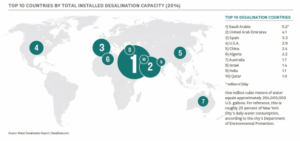Imagine that you wake up one morning, go over to your kitchen faucet to fill up your coffee machine, and no water comes out. How would you react? Most of us would call our water utility to ask why we aren’t being supplied with the water we pay for.
However, for the estimated 790 million people without access to an improved water supply, that isn’t an option. Fully 10% of the global population faces limited access to safe drinking water.
And demand for water is only expected to rise as the global population’s gross domestic product (GDP) per capita rises, and as water supplies diminish because of climate change and contamination. The United Nation’s 2015 World Water Development Report forecasts that there will be a 40% shortage of drinking water in the world by 2030.
Is there a solution?
The Potential of Desalination
Oceans hold 96.5% of all Earth’s water. They’re one of Earth’s most valuable resources, containing a majority of the water resources we need for a number of regulatory functions. And they could potentially hold some solutions to drinking water shortages.
Innovations in water supply technologies are leading the way in increasing water accessibility, especially in arid and water-scarce regions. In particular, desalination, or the process of removing salts from ocean water to produce freshwater, is becoming an increasingly viable option to meet domestic and municipal needs around the globe.

A recent United Nations study found that there are presently 16,000 desalination plants operating in over 177 countries, including northern Africa and the Middle East. These plants produce a volume of freshwater equivalent to almost half the average flow over Niagara Falls.
This form of water treatment can extend water supplies beyond the hydrological cycle, providing an essentially “unlimited” and climate-independent supply of freshwater.
However, there are limitations that prevent the more widespread adoption of desalination.
Analyzing the Impacts: Energy Intensity, By-Products, Cost
Currently, the adoption of desalination technologies is primarily occurring in high-income countries and nations where energy costs are low and environmental regulations are not as stringent (such as Saudi Arabia and the United Arab Emirates).

Several limiting factors prevent desalination from being adopted at a more widespread scale: high costs, energy inputs, and volume of waste products. There are several costs associated with desalination—treatment cost, delivery cost, and the actual cost to the consumer—that influence the economic sustainability of the desalination market.
Desalination is also the most energy intensive water treatment process, consuming over 75.2 terawatts of electricity per year, or approximately 0.4% of global electricity generation. The energy demand for desalination is primarily supplied by conventional fossil fuel-based resources, contributing to significant global carbon emissions.
In addition to the high energy inputs, a considerable by-product of the removal processes is toxic brine of highly concentrated saline water, which is often improperly disposed of by dumping it back into the sea. This poses immediate threats to aquatic organisms and oxygen levels in seawater.
A case study in the State of Qatar, in which 75% of the municipal water supply is derived from desalination processes, conducted a lifecycle analysis of the environmental impacts. Some of the key findings of the environmental impacts of desalination processes included water acidification, eutrophication (oxygen depletion leading to algal blooms), ozone layer depletion, and human and marine aquatic toxicity.
So, how do we make desalination processes more sustainable and accessible?
Rethinking the Experimental Design: A Focus Towards Greater Efficiency
Reducing both the costs and impacts of desalination in order to make it a more accessible option can be accomplished through technological advancements. Countries around the world have begun experimenting with energy innovations to increase the efficiency of desalination.
According to a review on the nexus between energy generation, water use, and environmental impact, the productivity and success of many desalination processes depends on several parameters, including:
- plant capacity and design
- available materials/resources
- feed water type and quality
- type(s) of desalination processes employed
In response, the integration of cogeneration systems, or the simultaneous production of both electricity and potable (drinkable) water, is becoming increasingly popular. While cogeneration systems do face some challenges, including the maintenance of complex operations and the variability of consumer demand for power and water, their benefits may outweigh the barriers to adoption. These include decreased energy costs, greater efficiency of the system, and lower carbon emissions from diversion into renewable energy sources.
Introducing renewable energy (solar, wind and tidal) as a primary source of electricity for desalination plants additionally reduces some of the negative environmental impacts associated with conventional fossil fuel-based energy generation.
The Future of Desalination
Overcoming projected global freshwater scarcity for a growing human population facing the impacts of climate change will require a collaborative and multifaceted approach. Increased efficiency in desalination design, coupled with renewable energy generation, can make its adoption more widespread and accessible for that 10% of the global population without access to an improved water supply.
As we move forward in the face of climate change, it is essential to consider and assess all of our options. Anticipated water scarcity projections will not be confined to specific regions or countries. Whether we’re talking about water scarcity in Libya or New Mexico, this is an issue that requires partnerships, collaboration, and technological innovation.
If you’re someone who doesn’t face daily water accessibility issues, keeping up with water accessibility news, donating to ethical organizations/charities, and investing in water development and desalination technology companies (Kurita, Energy Recovery, Hyflux Energy) can be effective steps to push towards the adoption of sustainable desalination processes.

